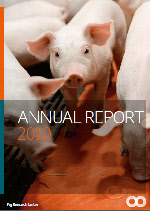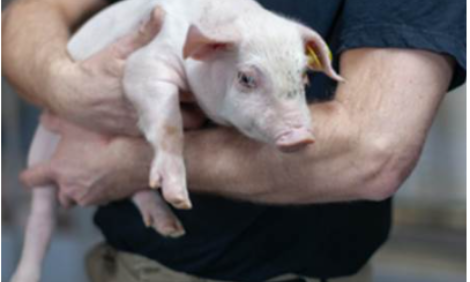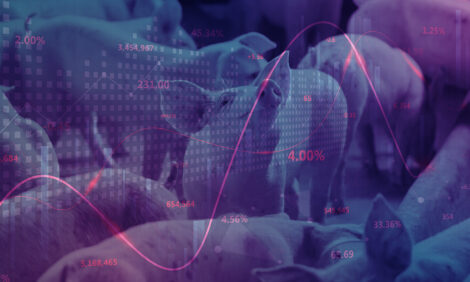



Danish Pig Research Centre: Annual Report 2010: Nutrition
The latest annual report from the Danish Pig Research Centre outlines research activities into phosphorus nutrition, feeding weaners and finishers, diet formulation and liquid feeding.
Phosphorus and Phytase
Debate about phosphorus and phytase
Phosphorus and the use of phytase were debated frequently in 2010, and Pig Research Centre has implemented several activities on this area. Besides those described here, read more in the section on heat stability of different phytases under 'Feeding of finishers'.
New phosphorus digestibilities
In April 2010, phosphorus digestibilities were reduced for the following ingredients when phytase is added in increasing inclusion rates:
- Soybean meal and soy protein concentrates
- Rapeseed cake/meal and rape seed
- Sunflower meal/cake
In practice, this means that the safety margin is increased under high inclusion of phytase.
New phosphorus standard for finishers
The most recent trial with phosphorus for finishers (trial report 812) demonstrated that daily gain as well as feed conversion improved when the old standard for digestible phosphorus was exceeded. In April 2010, the standard for digestible phosphorus was raised from 2.4 to 2.5g per feed unit.
Phosphorus and zinc oxide
Foreign studies have demonstrated that a high zinc content in pig feed reduces the effect of phytase. It is, therefore, recommended to increase the standard for digestible phosphorus by 10 per cent in feed for weaned piglets that includes zinc oxide prescribed by the herd veterinarian.
Suspected phosphorus deficiency
‘Investigation of phytase and phosphorus levels in practice’ is a project initiated in co-operation between veterinarians and pig advisors. On farms experiencing leg problems, farrowing problems, tail biting or other behavioural problems, it was investigated whether the feed contained sufficient amounts of digestible phosphorus.
Seventeen diets from 14 pig farms were analysed for content of calcium and phosphorus and phytase activity. The content of digestible phosphorus in these diets is shown in Figure 1.

Analyses of the feed revealed that only three of these 17 diets had a content of digestible phosphorus significantly below the standard. Large variations in phytase activity were found as shown in Figure 2.

In several cases, deficiencies in digestible phosphorus were found not to be triggered by the absence of phytase. The specific problems in those herds were in most cases related to other factors than phosphorus deficiency.
If phosphorus deficiencies are suspected, minimum three representative feed samples must be analysed for phosphorus and phytase activity before any conclusions are made.
Feeding of Weaners
Valine for weaners
Increasing inclusion rates of the amino acid valine in feed for weaners from 10 to 30kg was studied in a trial to demonstrate whether the standard for valine is correct. The curvilinear correlation between increasing inclusion rates of valine and production value is shown in Figure 1.

The maximum production value from 10 to 20kg was obtained with a valine percentage of lysine of 67 per cent and of 65 per cent from 10 to 30kg. The new valine standard for weaners weighing 6 to 9kg is 7.4 and for weaners 9 to 30kg, 7.0 standard digestible valine per feed unit (trial report 881).
Rapeseed products for weaners
As part of an extensive project on rape products, three different types of rapeseed cake of Danish origin and two types of rapeseed meal of Polish and German origin were studied for weaners in the growth period 11 to 30kg. All products were bought in Denmark and were compared with a control diet based on soybean meal.
There were no differences in production value between the groups. With German and Polish rapeseed meal, there was a tendency to a lower production value of 6.4 and 7.5 below control, which is explained by a lower gain and a poorer feed conversion (Table 1).
| Table 1. Productivity and production value in the trial period 11.0-28.7 kg | ||||||
| Control | Rapeseed cake | Rapeseed meal | ||||
|---|---|---|---|---|---|---|
| Soybean | Scanola | Danraps | Emmelev | German | Polish | |
| g/day | 549 | 537 | 526 | 536 | 518 | 524 |
| Feed units/day | 1.03 | 1.00 | 0.98 | 1.01 | 0.98 | 1.02 |
| Feed units/kg | 1.87 | 1.86 | 1.87 | 1.88 | 1.91 | 1.95 |
| Index | 100 | 98 | 96 | 97 | 93 | 92 |
The rape products contained different levels of glucosinolates: rapeseed cake had a higher content than rape seed meal. Rapeseed cake from Emmelev and the Polish and German rapeseed meal had a lower content of 4-hydroxy-glucobrassicin, which indicates that the products had been subject to strong heat treatment reducing the content of glucosinolates. However, harmful break-down products formed.
Heat damage may also destroy amino acids, particularly lysine, and in general reduce productivity levels. The nutrient content of the rape products varied greatly and this must be taken into consideration when formulating diets with rape products – simply using standard values is not enough (trial report 890).
Commercial diets
Commercial weaner diets selected by local pig advisors in Eastern Jutland were tested (2009/2010). The diets were bought from the following feedstuff producers (the obtained index for production value is written in parenthesis):
- Control (100)
- Aarhusegnens Andel (93)
- DLG (103)
- Hedegaard (104)
- ATR (92)
- Vestjyllands Andel (100)
The diet from Hedegaard resulted in a significantly better production than the diets from ATR and Aarhusegnens Andel. There were no significant differences in production value between the other diets. If a pig producer uses the diet from Hedegaard, the diet can cost, on average, DKK22 and 23 more than the diets from ATR and Aarhusegnens Andel to reach the same production value (trial report 871).
Feeding of Finishers
Heat stability of enzymes
The heat stability of the phytases Ronozyme NP and Phyzyme XP and of the xylanases Ronozyme WX, Econase XT 25, Porzyme 9302 and Danisco Xylanase 8000 G was investigated at a trial facility where temperature and duration of pelleting and conditioning could be monitored thoroughly. The products were tested in the temperature interval 80 to 100°C.
For both phytases and for the xylanases Ronozyme WX, Econase XT25 and Danisco Xylanase 8000G, more than 80 per cent of the enzyme activity was preserved up to 95°C. These products were comparable in terms of heat stability. Porzyme 9302 was less heat stable, and at 90°C xylanase activity was reduced to half of the activity recorded at 80 °C.
Pelleting and conditioning conditions at feedmills normally do not exceed 95°C and should therefore not cause problems for the activity of the tested enzymes with the exception of Porzyme 9302. In this trial, enzyme activity only illustrates heat stability and not the effect in the pig (trial report 875).
Porzyme 9302 and Ronozyme WX
Porzyme was previously tested with a positive outcome. Different inclusion rates were not tested at the same time, and Porzyme was never tested under Danish production conditions together with other corresponding xylanase products.
Porzyme 9302 and Ronozyme WX are, therefore, currently being investigated in different inclusion rates.
Zinc gluconate does not reduce tail-biting
Tail-biting is a common problem on many pig farms, and products are regularly marketed claiming to reduce tail-biting. The effect of adding 500g zinc gluconate per tonne finished feed was investigated on a pig farm with a high prevalence of tail-biting. The pigs given zinc gluconate in their feed were compared with a control group that was not given zinc gluconate. The diets included 110mg zinc per kg feed. The trial comprised 40 blocks and 1,439 pigs. No effect was found on tail-biting of adding zinc gluconate.
Energy content in feed

The effect of four different levels of energy (102, 105, 108 and 110 feed units per 100kg) with increasing wheat was investigated on one farm. The effect on productivity was recorded from 31kg until slaughter at 109kg.
The results revealed that the production values per place unit per year at the same price per feed unit were identical regardless of the energy content of the feed.
The production value per pig, where the increase in growth is not assigned a value, was also identical at increasing energy content despite a poorer feed conversion ratio and lean meat percentage.
This was partly explained by the fact that slaughter weight increased with increasing energy content. If the slaughter weight was identical in all groups, the production value per pig at the highest energy content (110 feed units per 100kg) would probably have been lower. In herds where a higher gain is financially utilised in the form of a higher slaughter weight or more pigs produced, it may be beneficial to feed the pigs a high energy content.
| Group | 1 | 2 | 3 | 4 |
|---|---|---|---|---|
| Feed units/100kg feed | 102 | 105 | 108 | 110 |
| Slaughter weight, kg | 82.0 | 83.0 | 83.1 | 83.9 |
| Daily gain, g/day | 894 | 917 | 929 | 942 |
| Feed intake, FUgp/day | 2.39 | 2.49 | 2.52 | 2.59 |
| FCR, FUgp/kg gain | 2.68 | 2.72 | 2.72 | 2.75 |
| Lean meat per cent | 60.8 | 60.4 | 60.5 | 60.2 |
| Production value/pig at id. feed prices, index | 100 | 99 | 99 | 98 |
| Production value/place units/year at id. feed prices, index | 100 | 100 | 101 | 100 |
When the prices of feed and finishers were included, the slightly better feed conversion and lean meat percentage at 102 feed units per 100kg was offset by a higher feed price, and there was no difference between the groups. The price per feed unit thereby determines the energy content, and the higher the price differences, the more movement towards a higher energy content.
An increase of the energy content of one feed unit per 100kg in the interval 102-110 feed units per 100kg feed with increasing wheat content resulted in an increase in daily gain of 6g, a reduction in FCR of 0.01 and a reduction in lean meat percentage of 0.1 percentage units (trial report 865).
All projects were financially supported by the EU and the Rural Development Programme under the Danish Ministry Food, Agriculture and Fisheries.
Feed and Feed Content
Silos for mineral diets

Approximately half of all Danish pigs are fed feed mixed on-farm based on mineral compounds. However, trials have demonstrated that home-mixed dry feed may segregate considerably.
Segregation may also occur if the ingredients used are not identical in particle size and volume. Segregation of mineral diets may adversely affect the productivity as the pigs get more or fewer nutrients than they need.
Pig Research Centre (PRC) therefore investigated whether mineral diets segregate when stored in and used from big bags, polyester silos or fibreglass silos, respectively (Trial Report 869).
The results revealed that amino acids or minerals do segregate when stored in and used from big bags or polyester silos. However, the extent of segregation was estimated not to affect productivity. Segregation of amino acids or minerals was not observed when stored in fibreglass silos.
Silo content – ETNA Tank

It is desirable to have a simple weighing system for silo control for routine monitoring of feed consumption. Leax A/S has developed a wireless recording system (ETNA Tank) for recording of silo content. A sensor is fitted on one of the silo legs, which means that the system can be used on all existing silos, and PRC therefore investigated the reliability and accuracy of the system (Report 1012).
The study revealed inadequate accuracy and reliability, and the way the system is operating today it cannot be used for routine monitoring of daily feed consumption and silo content.
The study indicated that the accuracy increased when sensors were fitted on all silo legs instead of on only one.
Energy content in feed
This season will see a new post on most accompanying feed notes: an I factor.
The I factor is used to check the feed units per kg of a diet, which simplifies the method for analysing FUgp/kg feed. This I factor will be used as a trial scheme until November 2011, and was introduced because of problems with the EFOSi analysis used when determining content of feed units.
Where energy content is declared, the accompanying notes for pig diets will include information on feed units as well as the new I factor replacing the EFOSi analysis when stating the content of feed units of a given diet. Until November 2011, PRC will continue to work on the problems related to EFOSi and determination of feed units in pig feed in co-operation with DAKOFO.
Standard values
PRC is routinely updating a feedstuffs table that provides access to applicable and updated standard values for the ingredients typically used when formulating diets.
Most recently, in June 2010 (Brief 1019), phosphorus digestibility and chemical content for soybean meal and rapeseed were updated. The inclusion of sodium was also revised for most feedstuffs.
Consequently, all diets formulated before May 2010 should be re-calculated to ensure that the nutrient standards are met and thereby ensure that the feed is not an obstacle to top results.
The above data and results are partly financially supported by the EU and the Rural Development Programme under the Danish Ministry of Food, Agriculture and Fisheries.
Liquid Feed
Fermented grain


During fermentation of grain, a microbial decomposition takes place of fibre in the grain, which increases the energy value of the grain. A digestibility trial with fermented barley and wheat revealed that the effect was greatest for fermentation of barley (trial report 873). This is probably due to the fact that barley has a higher content of fibre than wheat.
On the basis of the results of the digestibility trial, a finisher trial was conducted to investigate if the increased energy value during fermentation of grain was also found in a production trial.
Preliminary results indicate that in practice, the energy value in fermented grain is half that found in the digestibility trial. This means that you can save two to three per cent grain in a diet based on half-barley and half-wheat if the grain is fermented.
Cleaning and disinfection
Inadequate appetite among lactating sows given liquid feed is often correlated with the quality of the liquid feed. The micro-organisms that are naturally present in liquid feed may produce substances that change the taste of the feed when the feed ferments in the pipelines.
Some of the microorganisms in liquid feed may also trigger diseases such as diarrhoea, prolapsed rectum and intestinal haemorrhage, and are for these reasons unwanted in liquid feed. These pathogenic microorganisms are mainly coliform bacteria, clostridia and mould fungus.
An investigation on four pig farms demonstrated that cleaning and disinfection of liquid feeding systems does not change the quality of the liquid feed if the feed does not have a significant population of pathogenic micro-organisms.
For a long period, the four producers had been experiencing problems with low appetite among the sows, low weaning weight and diarrhoea among the piglets. Microbiological analyses of the feed reveal that it is unlikely that the quality of the liquid feed caused these problems.
On the basis of this investigation, it is not recommended to clean and disinfect liquid feeding systems, including pipe lines, unless microbiological analyses reveal the liquid feed to be of poor quality. It is still recommended to clean liquid feed tanks approximately once a week to remove coatings of old feed.
Inoculation culture
Feed intake among weaners may be low on some farms with liquid feed – just as among lactating sows.
It was studied if the use of inoculation culture can increase feed intake. Lactic acid bacteria and yeast isolated from liquid feed in herds with a high feed intake were used as inoculation culture in a trial with weaners.
The result revealed no positive effect on feed intake and gain of adding inoculation culture to liquid feed.
The project was conducted in co-operation with the Faculty of Agricultural Sciences, Aarhus University, and the Faculty of Life Sciences, Copenhagen University.
The projects were financially supported by the EU and the Rural Development Programme under the Danish Ministry of Food, Agriculture and Fisheries or received grants pursuant to the Innovation Act.
Further Reading
| |
- | Go to our previous article on this report by clicking here. |
September 2011








